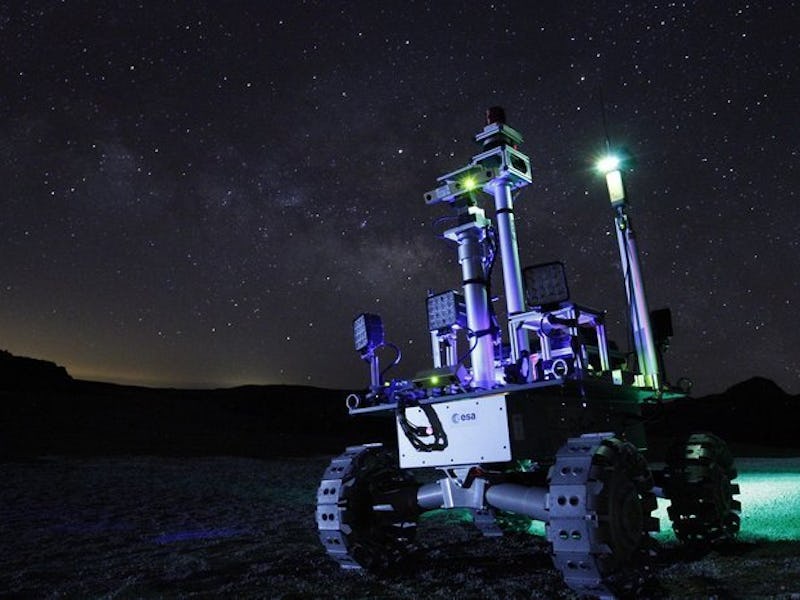These Rovers Will Traverse the Dark Reaches of the Moon
The lunar rovers must explore in near to complete darkness.

Scientists plan to land rovers on the shadowy poles of the moon to scour the lunar land for valuable deposits of frozen water.
Any moon colony or Mars-bound voyage will require water, and lacking many realistic alternatives, space explorers may need to melt down lunar ice — if it can be found. Unlike Martian rovers, which operate during daylight, exploring the always frigid lunar poles for ice means traversing a rock-strewn volcanic surface in the dark, where the sun stays low on the horizon and casts permanent shadows over the land. To prepare for such low-visibility exploration, European Space Agency scientists spent nine days in June driving the prototypical rovers at night over the volcanic grounds of Tenerife, the largest of Spain’s Canary Islands, and last week released photos of the mission.
The project, named Lunar Scenario Concept Validation and Demonstration (Lucid), tested guidance technology including cameras fitted with night lamps and sensors that shoot out lasers to perceive the physical world ahead. Because the moon is close enough to Earth for scientists to operate the rovers like a remote-control car, the rovers will need guidance on the uneven terrain that lies ahead.
A nocturnal lunar rover fitted with its various navigation sensors.
“You can imagine the stress of operating a multi-million euro rover with a joystick in near-total darkness,” said ESA robotics engineer Martin Azkarate in a statement. “With Lucid, we’re seeking to find out the best ways of navigating the lunar surface in varied illumination and terrain, analyzing different sensors and software tools.”
Once darkness fell, scientists sitting across the sea on the European mainland operated the two different rovers as they traversed the jagged terrain beneath the dormant Mount Teide volcano, one with four wheels and the other with six. ESA scientists also hope that one day these rovers can drive themselves autonomously, so engineers also tested out self-navigating software.
The two rovers traversing volcanic terrain at night.
“A faster, self-navigating rover is seen as a necessary technology for future missions, like self-driving cars on Earth,” explained Azkarate. “But with no roads, the rover will have to work out its own route — first by taking images, then using these to map the surrounding area, followed by identifying obstacles and planning a path to safely reach its assigned goal.”
One of the rovers traveled autonomously in darkness for upwards of more than 300 feet, and independently deduced when the terrain became too extreme to forge ahead. Robotic intelligence, then, might one day unearth the bounties of frozen water that Mars-bound astronauts will drink during their three-month voyage to the distant red desert.
The shadow-ridden craters of the lunar south pole.